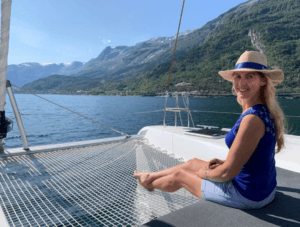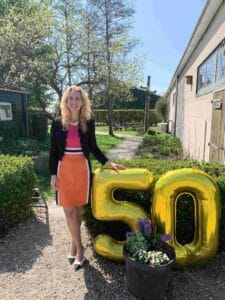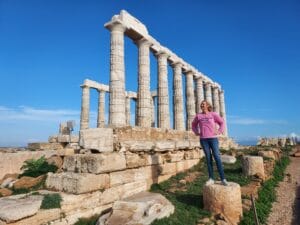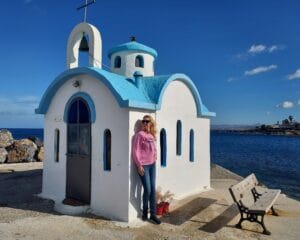We have sailed along the entire coast of North Spain. After Basque Country, there are 3 more regions in the North of Spain: Cantabria, Asturias and Galicia. We have sailed that trajectory from Bilbao to Muxia, on the map you can see all the places we have visited:

The top 5 places we liked best are described at the end. But first more about the sailing and coastline of the Northwest of Spain.
View of the coastline
When you are on your ship and you sail along these coastline, you get a magnificent view of the mountains here. For instance the Picos de Europa mountain range is impressive: high and steep grey or brown walls with jagged edges. Sometimes the mountains get more sloping and green, a lot of trees grow there, like pine trees and eucalyptus trees. At the bottom of the mountains you often find a bay with a (fishing)village and a harbor. And in between the villages so many beaches! The North Spanish coast has about 700 beaches and they all look very appealing: white or bright yellow colored sand and fresh green water.

Sailing here is hard!
We enjoy the landscape here, but sailing is hard along this coastline! Wind is so unpredictable, it can vary from 2 knots to 20 knots in the same hour and also the direction is often changing during the day. Normally it is N or NW wind, which is ideal when you sail from east to west like we were doing. But we experience what is called: ‘wind against stream’: the direction of the wind, the Atlantic Ocean stream and tides are often working in opposite directions. Which makes the ship wobble a lot and since the wind force is not that strong, the sails don’t get to opportunity to catch enough wind to give the catamaran the push forward. Which leaves us changing directions a lot during sailing to get some continuous wind in our sails. So this turnes a 4 hour sail into a 7 or 8 hour sail. A lot of seamiles lost.
We read in blogs of other sailors that this is exactly what they experience. Also the suddenly emerging fog is notorious in this area. We have also experienced that a couple of times. Out of nowhere fog comes up, leaving us with no more than 400 meters view. It forces you to turn on your radar to check if boats are heading your way, especially ships who don’t have an AIS (Automatic Identification System), so the radar can reveal their location. Because if you see a ship at a distance of 400 meters heading your way with a speed of 10 km/h, both sailingvessels have about 1,5 minute to change course to avoid a collision. That is not a lot of time…..
Achoring or Harbor?
The bays are beautiful here and easy to access with your ship. So we have anchored in the North of Spain 60% of the time and 40% of the time we were in harbors. Usually after 3 days of anchoring, relaxing and enjoying looking at nature, we feel like going to a harbor for 2 days to visit villages with our e-bikes, do shopping in supermarkets, eat at restaurants and do some clothes washing.
Anchoring or staying at a harbor: both choices have their advantages and disadvantages.
Anchoring is more easy: you chose a spot you like along the coast or in a bay, you drop your anchor, put on your anchor light for ships to spot you at night. And turn on your anchor alarm which goes off if your anchor starts to detach itself from the bottom. And that’s it. You have all the freedom you like, you can go swimming, you have no neighbors close by and anchoring usually is free. Unless you attach yourself to a mooring ball in a bay, you pay no fee when you anchor.
You have to watch your use of water and energy though when anchoring: we have 600 liters of fresh water, after 3 days it’s quite finished after all the toilet flushing, washing your hands, showering, etc.
We have a water maker onboard and can make freshwater out of seawater, but to clean your boat with a water hose to get rid of all the salt water, or to let your washing machine run, it’s better and quicker to be in a harbor and use the water there (and filling up your water supply again). And because we have a lot of solar panels installed and the sun is shining a lot in Spain, we have enough power to cook, shower, make coffee, use our laptops, let the dishwater run, etc. But again, a washingmachine uses a lot of water next to a lot of power, so that’s why we like to be in a harbor when using the washing machine.
Also to do some sightseeing, it’s nice to have our e-bikes ready and be in a harbor. When we are at anchor, in front of an island for example, we sometimes put the e-bikes in our dingue and go ashore to do sightseeing. But with your boat at anchor, you don’t go far. If the anchor alarm on your mobile phone goes off, it means your ship starts to drift, and that could also be in the direction of rocks or other ships…You don’t want to be 1 hour cycling away from your ship! And believe me, it has happened a few times that the anchor started to get loose and started to drift and scratch over the bottom. This occurs when the soil is mud in stead of solid sand, or if there is a lot of seaweed at the bottom and the anchor can’t get a good grip. Luckily, we were always on board when that happened (yes, also at 3.00h at night, the anchor can get loose!). So that kind of ‘stress’ you don’t have when you are in a harbor.
Harbors can be crowdy though, have a lot of noise (festivals, music played by neighboring boats or just shouting on the streets at night). Also you have to bring a lot of paperwork in the Spanish harbor office (passports, insurance policy of the boat, proof that the VAT is paid, ownership papers, engine numbers and power, etc. It usually takes half an hour to fill in all the paperwork.
And the prices for a catamaran in high season in a North Spanish harbor are € 60-€ 80 per night (low season € 40 – € 60). They charge x1,5 the price of a monohull (a ‘normal’ sailingboat) because you use the space of 2 boats having a catamaran. So 3 nights in a bay or 3 nights in a harbor can make a difference of € 200. And if this is your daily lifestyle, you don’t want to be in a harbor 365 days a year (you do the math 😊). Unless it’s Scotland in the winter of the Fjords in Norway with a dept of 700 meters.
Top 5 places (see the map above)
- Castro Urdiales
We liked the spacious harbor and lots of places to anchor. You have a view on the old castle, build in the Middle Ages. There are also a lot of remains of the Roman period in this part of the country. This town is a very beloved passage for the pilgrims on the northern route to Santiago de Compostella. We also loved the small streets with the tapas bars.



2. San Vicente de la Barquera
This little town was wonderful to walk around through. Many authentic shops. We bought calamari and baked it on a table grill on our boat (calamari or octopus is called ‘pulpo’ in Spain).
San Vicente is in the middle of Parque Natural de Oyambre, this means there are a lot of birds and other wildlife around. At the end of the estuary in the shallow water we could anchor in front an old stone bridge with arches. This spot meant we had to get up early to sail away during high tide, like on our way in, otherwise we would have to wait another 12 hours to leave. At 7.30h in the morning we sailed away, were treated with this beautiful orange sunrise:



3. Ribadesella
This was un expected surprise! A saying among sailors is: ‘You should sail when you can’, so since the wind came from the ‘right’ direction all of a sudden, we could sail a long track. So we ended up in Ribadesella, we didn’t do a lot of research on the city, we knew the entrance was a bit tricky with many curves. But once we had done the curves and were in the bay, we looked at an elegant place with a boulevard and white beaches in front. We stayed here for 1 day, walking on the beaches and admiring the view!
4. Gijon
This big city had a very comfortable harbor, which we enjoyed a lot. You had a view on the old city and many restaurants. There was also a festival going on, so the live music created a happy atmosphere in the city.
We needed a haircut, so we drove into the city and a friendly small barbershop had time for us on the spot. Our hair was washed, cut and dried: see picture below for the end result. When I was at the cash register, they told me it was € 23, which is cheap for a haircut compared to what I pay in the Netherlands. I wanted to pay for the both of us, so I asked for the total amount. It turned out, this actually was the total amount: € 10 for Gilles, € 13 for me. To tip is not very usual in Spain, you normally round the amount of to the nearest number. So in this case € 25 would be ok, but we left behind the hairdresser a bit confused with 40 euro’s 😊.



We loved the long beach area of Gijon. The city is proud to have stopped the Moors in ancient times, so there are still a lot of Roman influences here as well. We stayed in Gijon for 3 days (to do some washing, cleaning of the boat, etc). Since we had time, I took the bus to Oviedo (30 minutes) to walk around this charming city as well.
5. A Coruña
In between Gijon and A Coruña, you transition from the region Asturias to Galicia. New surroundings, new food: we tried the famous Galician cheesecake and sweet cider! And new encounters. Along this coast, we helped sailing vessel Silbo when their crew was in distress. And we met also some Dutch sailors, like Rene and Anoinette from sailingvessel Vento, a friendly couple enjoying sailing and working online in this south part of Europe.
A Coruña is a milestone for many sailors: it has a strategical position at the northwest point of Spain, so sailors from England, France, the Azores often sail many days from their starting point to get to A Coruña. The harbor is filled with boats from Scandinavia, Italy and other places. French, Dutch and British flags are the most seen on the boats here. It’s a sparkling atmosphere of people being happy they have reached the Spanish coastline!
We got the advice to go to Playa de las Catedrales. This beach is special because with high tide you see round rocks rise above the water, but with low tide, all of a sudden a wide beach unfolds and these round rocks turn out to be giant oval arches where you can walk underneath. This gives a totally different view! We saw both moments, at high tide and low tide.
Unfortunately, the local government decided to regulate the great number of visitors who want to be at the beach to walk under the arches. So you had to book a free online ticket to go on this public beach. And it was prebooked for 2 weeks…..
We were disappointed to have come to this beach, only to be able to look at the arches from a distance. Being Dutch, we are not so much impressed by authority as for instance the Germans or the French. We don’t easily take no for an answer. The word ‘no’ to us is more like an advice rather than a prohibition. So when the word ‘no’ is said to us, we hear: ‘Not this way, but maybe we can talk about other ways….?’. In this case, we could not imagine the authorities could block all the entrances to this extensive and fickle beach…
So we walked a bit further and around a corner, you could walk down a piece of moorland that gave entrance to a small groove with shallow water (up to 1 meter deep) which we could walk through to go to the arches. We saw more people do this, so we joined them. And we ended up walking underneath the arches and enjoying an afternoon on this beach!








